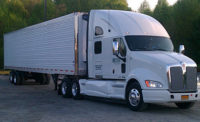It’s Friday afternoon and you and your DC staff are looking forward to a nice long, relaxing weekend. Suddenly, you get an alert that four reefer trucks full of ice  cream bars have arrived at your dock door. You quickly realize that you don’t have enough dock doors in the refrigerated section of your distribution center to handle four trucks, you don’t have enough forklift drivers certified for work in that section on duty and you don’t have enough free space or racking in the freezer section to hold that much product. Your next thought might be—what nut case ordered these? Or, why didn’t someone tell me about this?
cream bars have arrived at your dock door. You quickly realize that you don’t have enough dock doors in the refrigerated section of your distribution center to handle four trucks, you don’t have enough forklift drivers certified for work in that section on duty and you don’t have enough free space or racking in the freezer section to hold that much product. Your next thought might be—what nut case ordered these? Or, why didn’t someone tell me about this?
Even if you’ve never had to store or ship ice cream bars, you can likely relate to having to scramble because someone up the line made plans that were beyond your capacity to fulfill. Your company might even have tried instituting a monthly forecast meeting to help mitigate these kinds of problems. But how successful have you been in getting the people in purchasing or merchandising to understand or even care about your constraints such as dock doors, storage capacity or workforce limitations? The fact is, until you can get corporate planning systems intimately familiar with your real-world, ever-changing logistics constraints, you’ll be the one who ends up scrambling.
That’s why supply chain executives and DC managers should care about supply chain planning—it will make your life a lot easier.
Why current methods don’t work
The problem with current supply chain operations is that planning systems and execution systems work in silos. Although there has been recognition for over a decade that these systems should interact, any sharing of information between the systems so far has been limited to first-generation interfaces—a planning system passing a file listing what inventory has been ordered, for example. The problem is that the planning system has no visibility to the impact the plan has on warehouse or DC operations.
Therefore, you end up with scenarios such as:
• Purchasing taking advantage of volume discounting to make a large forward buy-matching planned inventory demand for the next six months, not realizing this will require operations to secure third-party warehouse space to handle the overflow.
• The transportation management system plans loads to transport 100% of this inventory to the DC, not knowing this is an unrealistic number of loads for the DC to handle in a given day.
• Neither the purchasing plan nor the transportation plan understands that there is not enough staff in the DC to handle the incoming loads and putaway requirements.
All three of the above disconnects between the planning systems and DC operations not only cause headaches for DC managers, but they also needlessly inflate distribution and logistics costs—potentially exceeding the savings the plans were intended to produce. There needs to be a better way.
How to solve the problem
The true value of an integrated planning and execution suite has not been realized because the planning systems have not been able to understand the constraints in the warehouse. As a result, unworkable plans like the examples above keep making life difficult for DC managers.
What is needed is the next generation of integrated planning and execution that will fulfill the promise of real integration, enabling the systems to act as if they are one. What this means is that the planning systems that plan production schedules, purchases of goods and materials or shipments to facilities, stores or customers will be fully cognizant of constraints on dock doors, loading and unloading times and equipment, storage capacity, labor availability and skill sets and other constraints on each DC’s ability to execute the plan.
There are two enabling capabilities that are required to achieve this next generation of integration. The first is supply chain visibility. Because plans are by nature forward-looking—for example, planning a promotion that will launch in six weeks—it is not enough to just to know current constraints. The planning systems also need visibility to the expected receipts from production and suppliers so that plans can be created based on anticipated constraints at the time they will be executed. This requires real-time visibility across extended supply chain networks.
Of course, we all know that even the best plans can be tripped up by unanticipated events—a truck breaks down or is in an accident, a forklift driver damages a pallet of goods, a DC is flooded or has a fire—and this list could go on. Therefore, the second requirement is that the planning process must be iterative to account for these events and create new plans that are workable based on the current reality. Only in this way will DC managers be able to stop scrambling to deal with unworkable plans.
The accurate, constraint-based plans created by this next generation of integrated planning and execution systems will have benefits for DC managers beyond ending the scrambling. The planning information can be used to re-slot pick faces to better profile picking locations based on velocity. It can also be used to properly manage the time-phased replenishment going to the DCs and stores. The plans can also be shared with carriers to ensure necessary truck capacity will be available.
DC managers and supply chain executives should take note because it will make distribution operations run smoother, more efficiently and with a lot less headaches—and no more melting ice cream bars on a Friday afternoon.



